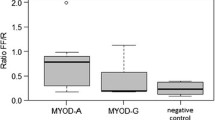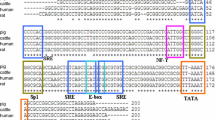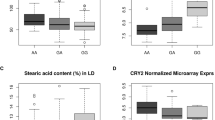Abstract
MYOG andMYF6 belong to theMyoD gene family. They code for the bHLH transcription factors playing a key role in later stages of myogenesis: differentiation and maturation of myotubes. Three SNPs in porcineMYF6 and two in porcineMYOG were analysed in order to establish associations with chosen carcass quality and growth rate traits in Polish Landrace, Polish Large White and line 990 sows. No statistically significant effect of SNP in the promoter region of theMYF6 gene on its expression measured on mRNA level was found. Associations between the genotype at theMYF6 locus and carcass quality traits appeared to be breed-dependent. The C allele in the case of SNP in the promoter region and GC haplotype in exon 1 were advantageous for right carcass side weight in Polish Landrace sows and disadvantageous for this trait in Polish Large White sows. These gene variants were also the most advantageous for loin and ham weight in sows of line 990. The mutation in exon 1 of theMYOG gene had no statistically significant association with carcass quality traits and the mutation in the 3’-flanking region had the breed-dependent effect as well. These results suggest that SNPs analysed in this study are not causative mutations, but can be considered as markers of some other, still unrevealed genetic polymorphism that influences the physiological processes and phenotypic traits considered in this study.
Similar content being viewed by others
References
Buckingham M, 1992. Making muscle in mammals. Trends Genet 8: 144–148.
Bober E, Lyons GE, Braun T, Cossu G, Buckingham M, Arnold AA, 1991. The muscle regulatory gene, MYF-6, has a biphasic pattern of expression during early mouse development. J Cell Biol 113: 1255–1265.
Buonanno A, Apone L, Morasso MI, Beers R, Brenner HR, Eftime R, 1992. The MyoD family of myogenic factors is regulated by electrical activity: isolation and characterisation of a mouse Myf-5 cDNA. Nucl Acids Res 20: 539–544.
Carjaval JJ, Cox D, Summerbell D, Rigby PWJ, 2001. A BAC transgenic analysis of theMrf4/Myf5 locus reveals interdigitated elements that control activation and maintenance of gene expression during muscle development. Development 128: 1857–1868.
Chomczyński P, Sacchi N, 1987. Single-step method of RNA isolation by acid guanidinium thiocyanate-phenol-chloroform extraction. Anal Biochem 162: 156–159.
Cieślak D, Kapelański W, Blicharski T, Pierzchała M, 2000. Restriction fragment length polymorphism inmyogenin andmyf3 genes and their influence on lean meat content in pigs. J Anim Breed Genet 117: 43–55.
Cieślak D, Kurył J, Kapelański W, Pierzchała M, Grajewska S, Bocian M, 2002. A relationship between genotypes atMYOG, MYF3 andMYF5 loci and carcass meat and fat deposition traits in pigs. Anim Sci Pap Rep 20: 77–92.
Comings DE, MacMurray JP, 2000. Molecular heterosis: a review. Mol Genet Metabol 71: 19–31.
Coutinho LL, Morris J, Marks HL, Buhr J, Ivarie R, 1993. Delayed somite formation in a quial line exhibiting myofiber hyperplasia is accompanied by delayed expression of myogenic regulatory factors and myosin heavy chain. Development 117: 563–569.
Ernst CW, Vaske DA, Larson RG, Rotschild MF, 1993. Rapid communication:MspI restriction fragment length polymorphism at the swine myogenin locus. J Anim Sci 71: 3479.
Fujii J, Otsu K, Zorzato F, de Leon S, Khanna VK, Weiler JE, O’Brien PJ, MacLennan DH, 1991. Identification of a mutation in porcine ryanodine receptor associated with malignant hyperthermia. Sci 253: 448–451.
Grant AL, Gerrard DE, 1998. Cellular and molecular approaches for altering muscle growth and development. Can J Anim Sci 78: 493–502.
Hasty P, Bradley A, Morris JH, Edmondson DG, Venuti JM, Olson EN, Klein WH, 1993. Muscle deficiency and neonatal death in mice with targeted mutation in themyogenin locus. Nature 364: 501–506.
Kapelański W, Kurył J, Bocian M, Rak B, 1999. The effect of RYR1 gene on meat quality traits in Polish Landrace, Pietrain and Złotnicki Spotted pigs. Adv Agric Sci 4: 39–44.
Kawasaki ES, 1990. Sample preparation from blood, cells and other fluids. In: Innis G.H, Gelfand D.H, Sninsky J.J, White T.J, eds. PCR Protocols: A guide to methods and applications. Acad. Press: New York: 3–12.
Kerst B, Mannerich D, Schuelke M, Stoltenburg-Didinger G, von Moers A, Gossrau R, et al. 2000. Heterozygous myogenic factor 6 mutation associated with myopathy and severe course of Becker muscular dystrophy. Neuromusc Disord 10: 572–577.
Kitzmann M, Fernandez A, 2001. Crosstalk between cell cycle regulators and the myogenic factor MyoD in skeletal myoblasts. Cell Mol Life Sci 58: 571–579.
Koćwin-Podsiadła M, Kurył J, Przybylski W, Kaczorek S, Rozenek-Przybylska A, 1993. Efekt genu HALn w zakresie użytkowości rzeźnej i jakości tuczników linii pbz-23. [Effect of the HALn gene on carcass traits and quality of porkers of line pbz-23]. Zeszyty Naukowe Przeglądu Hodowlanego 9: 211–216.
Kurył J, Korwin-Kossakowska A, 1993. Genotyping of HALlocus by PCR method explains some cases of incomplete penetrance of HALn gene. Anim Sci Pap Rep 11: 271–277.
Lassar AB, Buskin JN, Lockshon D, Davis RL, Apone S, Hauschka SD, Weintraub H, 1989. MyoD is a sequence-specific DNA binding protein requiring a region of myc homology to bind to the muscle creatine kinase enhancer. Cell 58: 823–831.
Montarras D, Chelly J, Bober E, Arnold H, Ott MO, Gros F, Pinset C, 1991. Developmental patterns in the expression of Myf-5, MyoD, myogenin and MRF4 during myogenesis. New Biol 3: 592–600.
Nabeshima Y, Hanaoka K, Hayasaka M, Esumi E, Li S, Nonaka I, Nabeshima YI, 1993.Myogenin gene disruption results in perinatal lethality because of severe muscle defects. Nature 364: 532–535.
Nikovits W Jr, Mar JH, Ordahl CP, 1990. Muscle-specific activity of the skeletal troponin I promoter requires interaction between upstream regulatory sequences and elements within the first transcribed exon. Mol Cell Biol 10: 3468–3482.
Różycki M, 1996. Zasady postępowania przy ocenie świń w stacjach kontroli użytkowości rzeźnej trzody chlewnej [Guidelines for pig quality assessment at pig performance control stations]. In: Stan hodowli i wyniki oceny świń [Current state of pig breeding and assessment results]. Instytut Zoo-techniki [Insitute of Animal Husbandry], Kraków: 69–82.
Soumillion A, Erkens JHF, Lenstra JA, Rettenberger G, te Pas MFW, 1997. Genetic variation in porcine myogenin gene locus. Mamm Genome 8: 564–568.
Statistical Analysis System Institute, 2001, SAS/STAT user’s guide, version 8.2, SAS Institute Inc, Cary, NC,USA.
Te Pas, MFW, Visscher AH, 1994. Genetic regulation of meat production by embryonic muscle formation: a review. J Anim Breed Genet 111: 404–412.
Te Pas MFW, Soumillion A, Harders FL, Verburg FJ, van den Bosch TJ, Galesloot P, Meuwissen THE, 1999. Influences of myogenin genotypes on birth, growth rate, carcass weight, backfat thickness, and lean weight of pigs. J Anim Sci 77: 2352–2356.
Te Pas MFW, Verburg FJ, Gerritsen CLM, deGreef KH, 2000. Messenger ribonucleic acid expression of the MyoD gene family in muscle tissue at slaughter in relation to selection for porcine growth rate. J Anim Sci 78: 69–77.
Vykoukalova Z, Knoll A, Dvorak J, Rohrer GA, Cepica S, 2003. Linkage and radiation hybrid mapping of the porcineMYF6 gene to chromosome 5. Anim Genet 34: 238–240.
Wyszyńska-Koko J, Kurył J, 2004. PorcineMYF6 gene: sequence, homology analysis, and variation in the promoter region. Anim Biotech 15: 159–173.
Wyszyńska-Koko J, Kurył J, Flisikowski K, 2004. Partial sequence of porcineMYF6 gene, its comparative analysis and a novel polymorphism of the region coding for basic domain. Bioch Genet 42: 411–418.
Wyszyńska-Koko J, Kurył J, 2005. A novel polymorphism in exon 1 of the porcinemyogenin gene. J Appl Genet 46: 399–402.
Yoon JB, Li G, Roeder RG, 1994. Characterization of a family of related cellular transcription factors which can modulate Human Immunodeficiency Virus type I transcription in vitro. Mol Cell Biol 14: 1776–1785.
Author information
Authors and Affiliations
Corresponding author
Rights and permissions
About this article
Cite this article
Wyszyńska-Koko, J., Pierzchała, M., Flisikowski, K. et al. Polymorphisms in coding and regulatory regions of the porcineMYF6 andMYOG genes and expression of theMYF6 gene inm. longissimus dorsi versus productive traits in pigs. J Appl Genet 47, 131–138 (2006). https://doi.org/10.1007/BF03194612
Received:
Revised:
Accepted:
Issue Date:
DOI: https://doi.org/10.1007/BF03194612




